
Haarlem is a city and municipality in the Netherlands. It is the capital of the province of North Holland. Haarlem is situated at the northern edge of the Randstad, one of the more populated metropolitan areas in Europe; it is also part of the Amsterdam metropolitan area. Haarlem had a population of 162,543 in 2021.

Heemstede is a town and a municipality in the Western Netherlands, in the province of North Holland. In 2021, it had a population of 27,545. Located just south of the city of Haarlem on the border with South Holland, it is one of the richest municipalities of the Netherlands.

Hillegom is a town and municipality in the Western Netherlands, in the province of South Holland. Hillegom is part of an area called the Duin- en Bollenstreek. As such, a large portion of the local economy was traditionally geared to the cultivation of bulb flowers.
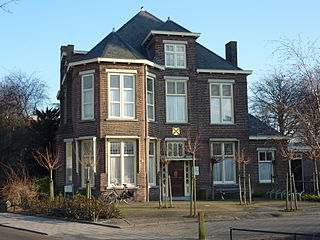
Voorhout is a village and former municipality in the western Netherlands, in the province of South Holland. The former municipality covered an area of 12.59 km2 (4.86 sq mi) of which 0.33 km2 (0.13 sq mi) is covered by water, and had a population of 14,792 in 2004. Together with Sassenheim and Warmond, it became part of the Teylingen municipality on January 1, 2006. Voorhout is located in an area called the "Dune and Bulb Region".

Witte van Haemstede was a bastard son of Floris V, Count of Holland, famous for military prowess.

Jacob Gilles was Grand Pensionary of Holland from 23 September 1746 to 18 June 1749.
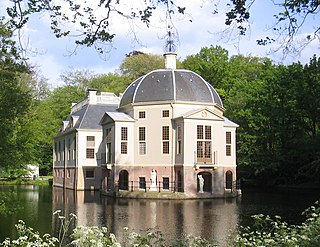
A buitenplaats was a summer residence for rich townspeople in the Netherlands. During the Dutch Golden Age of the 17th century, many traders and city administrators in Dutch towns became very wealthy. Many of them bought country estates, at first mainly to collect rents, however soon mansions started to be built there, which were used only during the summer.
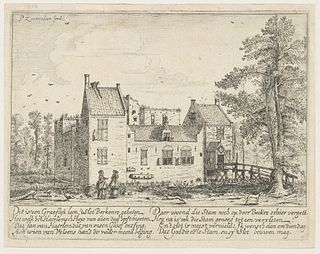
Berkenrode, or Berckenroode is a former 'Heerlijkheid' in the Dutch province of North Holland, situated on the southwest side of Haarlem on the leidsevaart, north of Iepenrode and west of Heemstede. The original castle Berkenrode in the center of the moat was burned by the Spanish during the siege of Haarlem in 1572. The castle was rebuilt and despite suffering another fire in 1747 the settlement continued to function as a separate municipality with its own chapel up to 1857, when the town was annexed by Heemstede. The town archives are now kept at the North Holland Archives in Haarlem.

Trekschuit is an old style of sail- and horse-drawn boat specific to the Netherlands, where it was used for centuries as a means of passenger traffic between cities along trekvaarten, or tow-canals.

De Naald is a monument in Heemstede, Netherlands, erected in 1817 by the city council to commemorate two battles on the Manpad road running next to the site. The site is at the corner of the Manpad, and Herenweg, on property belonging to the estate 'Huis te Manpad'.

The Haarlemmertrekvaart [ˌhaːrlɛmərˈtrɛkfaːrt] is a canal between Amsterdam and Haarlem in the province of North Holland, the Netherlands. It was dug in 1631, making it the oldest tow-canal in Holland. Travel on such canals was historically done by barges which were towed by animals on a path along the canal's edge (towpath).

John Hope, also known as Jan Hope, was a wealthy Dutch banker, participating in Hope & Co., a member of the city council and an art collector. In 1770 he was appointed as manager of the Dutch East India Company (VOC). He is also known today for his Groenendaal Park in Heemstede, where he summered on his estate. Shortly before he died he bought the nearby "Bosbeek". This estate became one of the first examples of a large garden in the 'English Style' in the Netherlands, and shaped by his second son Adrian Elias. His oldest son Thomas Hope became a designer of neoclassical interior decoration, and his youngest son Henry Philip Hope a gem collector and jewelry specialist.

The Duin- en Bollenstreek is a region in the Western Netherlands, that features coastal dunes and the cultivation of flower bulbs. Situated at the heart of historical Holland nearby the city of Leiden, South Holland, it is bordered by The Hague to the west and Haarlem to the north. The combination of beaches, flower fields, lakes and history makes this area attractive to tourists.

Flower bulb cultivation is an economic activity in the provinces of North Holland, South Holland and Flevoland. The colourful flower fields that have come to symbolise Holland can be seen in these areas around April.
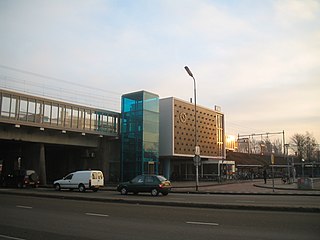
Heemstede-Aerdenhout is a railway station in Heemstede and Aerdenhout, Netherlands. The station opened on 1 October 1891 and is located on the site of the old Toll house for the Leidsevaart canal, which still flows next to the station from Haarlem to Leiden. This canal still follows the Oude Lijn closely. The train soon became the favored method of travel after the station opened, and the canal has gone out of use since the end of the second world war. The current station building was opened in 1958 and was one of the first Dutch viaduct stations.
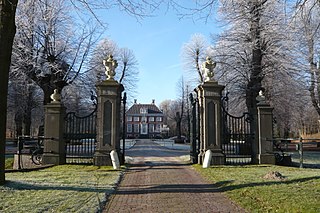
The Huis te Manpad is an historical villa and former summer home of Jacob van Lennep in Heemstede, the Netherlands; bordered by the Leidsevaart canal, the Manpadslaan, and the Herenweg. It neighbors the estate of Hartekamp, famed for the gardens described by Carl Linnaeus. Both estates still have trees and other flora dating from that period.

Iepenrode, or Ipenrode, is the name of a villa in Heemstede, the Netherlands, between the Leidsevaart and Herenweg, located north of Huis te Manpad and south of Berkenrode. It was once the summer home of various mayors (burgemeesters) of Haarlem and is currently privately owned.

Joseph Coymans, was a Dutch businessman in Haarlem, known best today for his portrait painted by Frans Hals, and its pendant, Portrait of Dorothea Berck. The former resides at the Wadsworth Atheneum in Hartford, the latter at the Baltimore Museum of Art. A portrait of the couple's son Willem is held by the National Gallery of Art in Washington, D.C.

Haerlempjes refer to a specific genre of landscape painting that includes a view of Haarlem. It is used most often to refer to Jacob van Ruisdael's panoramic views of the city, but the term is derived from mentions in Haarlem archives as a type of painting included in household inventories. The diminutive suffix "pje" would denote a small, cabinet-sized painting, but even the largest landscapes may be referred to as Haerlempjes today.
Jan Gaykema Jacobsz. was a Dutch painter, draughtsman and botanical illustrator.






















